Welcome the return of Crispi to the American market, albiet a mere pinky toe of a slice of the total US market. The fit difference between a Crispi and Scarpa is small, but significant. They are more accommodating for feet with a higher roof, the height of the instep, and perhaps a tad wider, but not much. In the downhill department is where most people will notice the difference.
Turn, Turn, Turn
The boots are undeniably stiffer than Scarpa’s TX and TX-Pro, but still not as stiff as the original Crispi Evo five years back – that was over the top. They are more on par with a T-Race, and likewise they do break down a bit after 100 days. Depending on what size foot you have, you may find the breakdown a bit difficult, especially if you are on the short end of the stick relative to the NTN sole length. The greater the distance between the 2nd heel and the bellows, the harder it is to get the sole to flex at the back of the met’s – the coveted ball-of-foot pressure point. It is also worth noting this flex phenomenon is more problematic with TTS bindings than it is with the NTN Freedom or Freeride bindings.Both the Shiver and Evo come with a carbon reinforced cuff for a better power transfer from your lower leg. In my experience the carbon is subservient to the effects of the cuff height or number of buckles. It helps, but mostly as a marketing bullet point.
For some, the instep buckle is the key feature to good performance with this boot. It holds your heel firmly in the pocket, whether driving a deep tele turn, or in skinning mode to keep blisters at bay.
It is worth noting these boots have two forward lean positions when you lock the cuff, giving a choice of more upright, or forward position to initiate turns from. Most tele boots only have one.
Tour Mode
In tour mode neither the Shiver or the Evo set any records for cuff touring mobility. The mode switch is typical, a lever on the heel spine that flips up to tour, or down to lock. When up, the cuff flexes back to vertical, giving your shin 10° rear movement from the ankle. If you’ve been in the tele camp for awhile you know that level of cuff mobility isn’t bad, it just isn’t that great compared to AT boots. Neither are these boots light. At 3½+ lbs./boot (Shiver), they are more of a mid-weight PTB.You may be inclined to look closer at the Shiver if you want to save weight, but I don’t think it’s worth saving few ounces for the climb to compromise performance from a solid 2-buckle cuff to a low cut, single-buckle cuff. It isn’t the single buckle that’s the problem, but how low it is. Scarpa’s TX has a single buckle, but it is noticeably higher, and thus more effective. The low buckle on the Shiver didn’t provide enough pressure to prevent my heel from rising, YMMV. Two buckles and a taller cuff would have helped, hence my recommendation for the Evo over the Shiver.
Fit
Part of that heel lift is due to the shape of the last, or in this instance, lack thereof. Most boots have some sort of constriction behind and above the heel to provide resistance to heel lift. The Crispi last resembles the inside of a beer can. This may be something your foot prefers, but not mine.
Aside from the lack of sculpting around the heel, the last seems good for average to above-average volume feet. To adjust for micro-variance, a wrap-style, heat-moldable Palau liner is provided. It has a soft fleeced inner skin and a mid-density foam that delivers plenty of adaptability when heated, but holds firm after molding for excellent power transfer through the lower leg, and comfort for your feet.
Gimme some Trim
Buckle wise, again, Crispi doesn’t provide anything distinctive, just micro-adjustable metal buckles. There isn’t even a touring tooth on the cuff buckles. I don’t use those much anyway, but when Crispi gets around to updating the design of their boots, this would be an easy place to make improvements.One of the compelling reasons to consider these boots are the Dynafit fittings. No, they’re not genuine Dyanfit, but they work fine as long as you are willing to do a little whittling of the sole behind the toe inserts. The width of the sole behind the inserts needs to remain about the same width as the pins for a good 5-6mm. If it is too wide, as is the case for the Shiver and Evo Rando models, the width of the sole will contact the toe wings (aka arms) and force them apart. It’s not a lot, around 40 mils (1mm ), but it’s enough to make the bindings release prematurely.
The solution is simple. Grind the sole back about ¼” (6mm) behind the inserts so it doesn’t touch the wings of the toe when the boot is flat. Once you’ve resolved that manufacturing fax paus you are free to be a switch hitter and lock the heel with a Radical, or get radical with a TTS, the 2-pin tech binding for tele.Conclusion
Feature wise Crispi doesn’t offer anything that isn’t available on comparable telemark boots except a different fit, and generally a stiffer flex for an NTN boot. The biggest hindrance to knowing whether their fit is more appropriate is being able to try them on. For the moment, unless you’re within striking distance of the Fey Brothers in New Hampshire, you’ll have to guess well and buy online. Next year it looks like more retailers will be on board, so there is hope to try before you buy.
Crispi
Evo
MSRP: $750
Weight/boot: 4 lbs., 2 oz. (1890 g)
Sizes available (mondo): 25.5 – 30.5
Shiver
MSRP: $600
Weight/boot: 3 lbs., 9 oz. (1610 g)
Sizes available (mondo): 24.0 – 30.5
Related Posts
NB’s review of Crispi Evo Rando on BCTalk
© 2014

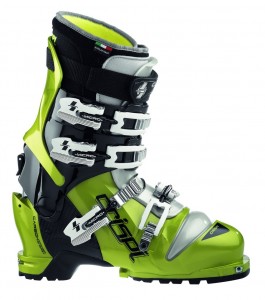
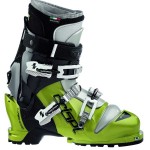
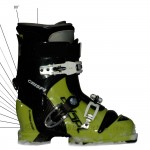
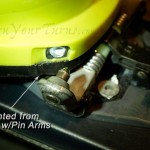
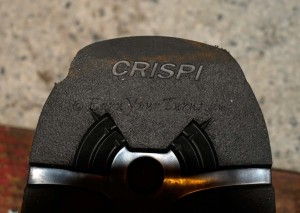
3 pings
Thank you very much for your blog.
I enjoyed reading this article.